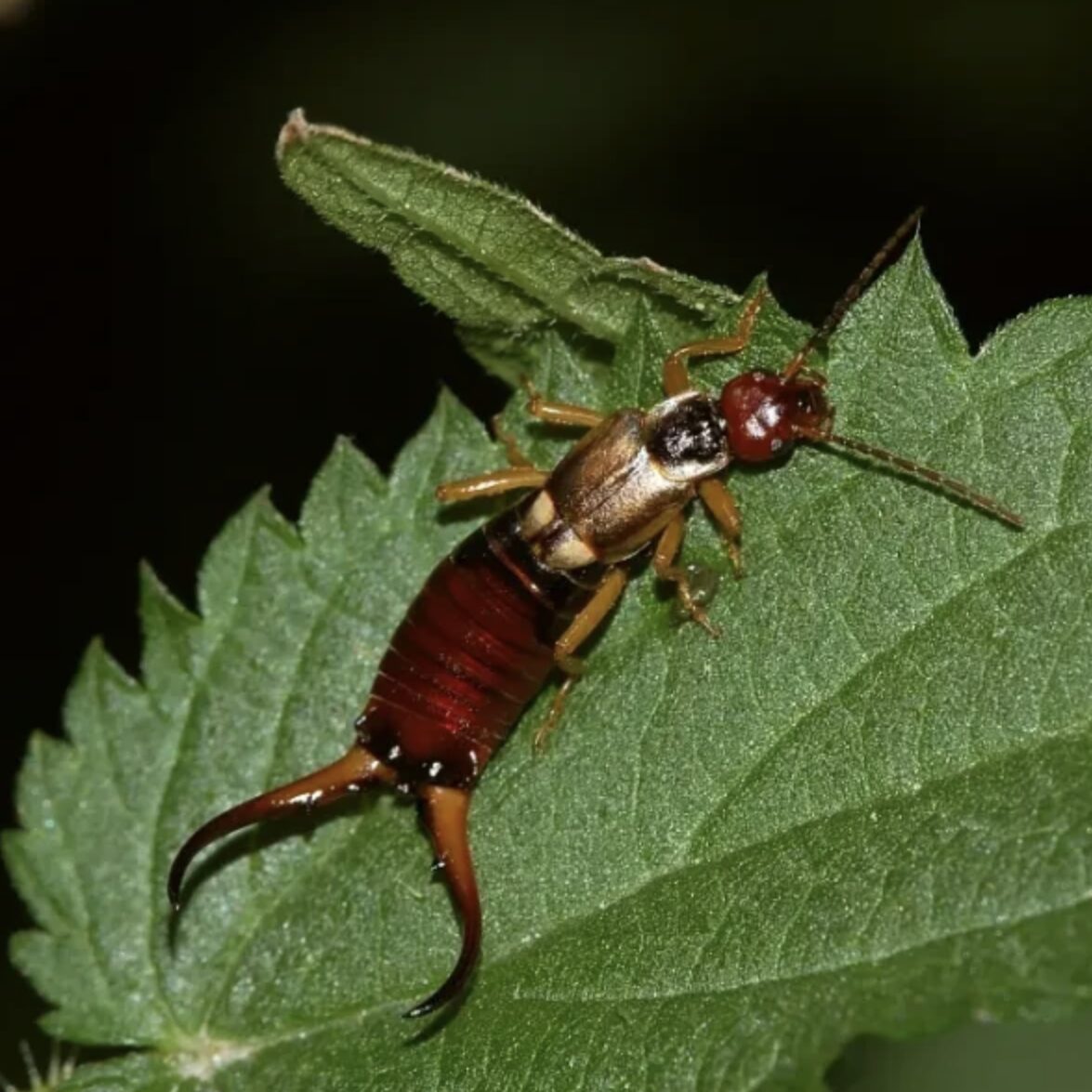Earwigs, slugs and snails require humid, damp habitats for shelter and reproduction. They hide during the day, and then come out to feed and scavenge at night. In New England, we most often see the European Earwig, which is an insect, and several different species of slugs and snails, which are mollusks. Generally earwigs and slugs, rather than snails, damage garden plants. Similar management strategies apply for these insects and mollusks because they share similar feeding behaviors and habitat preferences.
First, try to eliminate hiding places for these creatures. Remove piles of boards, stones, and debris. Prune away leafy branches of shrubs and trees growing close to the ground; eliminate weedy areas around trunks of woody plants and dense ground covers near flower and vegetable gardens. By reducing the hiding areas, earwigs and slugs will congregate in sheltered places such as low fence ledges, under wooden porches and decks and in stonewalls. Place traps in these locations when populations are high so you can capture and dispose of them.
In the garden, harvest tomatoes, peppers and melons before they become soft and discard culls away from the garden. Focus management strategies on seedlings, which these pests favor. Apply mulch around plants susceptible to damage, such as basil, beans, cabbage, corn, lettuce, strawberries and marigolds later in the season after plants have hardened and matured. Maintain compost piles away from the garden and turn them frequently. Use drip irrigation rather than sprinklers to reduce overall humidity and moist surfaces.
Toads, garter snakes, ground beetles, shrews, moles and salamanders prey on slugs and snails. Several kinds of flies parasitize earwigs and provide a measure of control. Avoid the use of broad-spectrum pesticides in your garden to help protect these beneficial animals.
You can recognize earwigs by the characteristic “pincers” projecting from the end of their abdomen. This rather flat, reddish-brown insect measures about 3/4” long as an adult. Immature earwigs, 1/8” – 1/2” long, look like the adults though they are often lighter or darker in color.
Earwigs breed and nest in the soil, especially under wood, stone, mulch, compost and debris piles. Female earwigs nurture and guard their young. They scavenge opportunistically: soil organisms, fungi, algae, eggs and immature stages of insects, such as fleas and aphids, as well as snails and other slow-moving invertebrates. Thus, they serve as beneficial predators of some pests. Earwig damage is often minimal and tolerable, unless the population becomes too high.
In the vegetable garden they may feed on seedlings, plant leaves, flowers, and soft fruit and on corn silk, which can interfere with pollination. Immature earwigs tend to feed on seedlings and young leaves. Adult earwigs will feed on flowers and will climb into fruit trees, especially peaches, to feed on soft fruit. Younger plant leaves may have small holes all over the leaf and older leaves tend to be chewed around the edges. Leaves chewed by earwigs often have a ragged look. Because earwigs forage at night, the best way to identify whether they are causing damage in your garden is to look for them with a flashlight at night.
Another way to determine if earwigs are responsible for damage, as well as to help control them, is to trap them. Place low-sided cans, such as cat food or tuna fish cans with 1/2” of oil (fish oil or vegetable oil with a drop of bacon grease) in the bottom, so that the top edges are level with the soil. Other traps include rolled up damp newspaper, moistened cardboard tubes, or an 18” piece of hose with the ends cut at a slant and placed in shady areas of the garden at night. Check the cans and traps in the morning. Shake earwigs from the tubes into soapy water, and bury captured, dead earwigs. Several days of intensive trapping should reduce the population significantly.
Slugs are dark gray, black, yellow or brown wormlike mollusks. The three different species of garden slugs we generally encounter in Massachusetts may be covered with spots and range in size from 3/4” to nearly 4” long. Snails, unlike slugs, have shells into which they can retreat. In New England gardens there are two species of snails that usually eat dead plant tissue and only occasionally eat green plants. Slugs and snails usually feed at night or on cloudy, wet days.
Slugs tend to cause more damage than snails. They prefer succulent foliage of flowers, primarily seedlings and herbaceous plants, but will eat holes in soft fruit such as tomatoes and strawberries ripening near the ground. To identify slug damage, look for ragged holes in leaves close to the ground and shiny trails of dried slime left by the foraging slug. The slug glides along a path of mucus secreted by a special gland below its mouth and a residue often remains where the slug has crawled.
To control slugs (and snails), use habitat and cultural management supplemented by handpicking, trapping, repellents and baits. A combination of these methods achieves the best results. Handpicking, if done regularly and systematically – looking in likely hiding places – for a few days can yield good results and after that, weekly handpicking may be enough. Draw out slugs and snails by watering the infested area in the late afternoon. Then, after dark, search for them with a flashlight. Wear gloves and drop the slugs in soapy water. Bury the dead slugs in your compost pile.
Take advantage of slugs’ tendency to congregate with other slugs in familiar shelters. Trap snails under boards raised an inch or so off the ground, or under inverted melon or grapefruit rinds, and scrape them off in the morning. These traps are less labor-intensive than traps baited with yeast or beer. Baited traps must have deep, vertical sides to keep slugs and snails from crawling out. If you make or purchase slug traps they should be 6” deep and 4” in diameter, buried so that the top edge is level with the soil, and have a reflective cover to keep the interior of the trap cool and dark. Bury baited traps 6’ – 8’ apart at the perimeter of an infested area.
Slugs avoid crawling over anything dry, dusty or scratchy, such as sand, coarse sawdust, fine gravel, wood ash and ground limestone. Use these materials sparingly to band and protect planted areas. Consider that both limestone and wood ash will raise the pH of the soil.
Copper foil strips, mesh or rings placed where slugs are active act as a repellent barrier. The copper emits a small electrical charge that repels slugs. Baits that contain iron phosphate are effective and reportedly safe around pets and wildlife if used as directed. Slugs consume the bait, become less mobile and begin to die within three to six days.
Source: Center for Agriculture, Food, and the Environment, UMass Extension Landscape, Nursery and Urban Forestry Program








